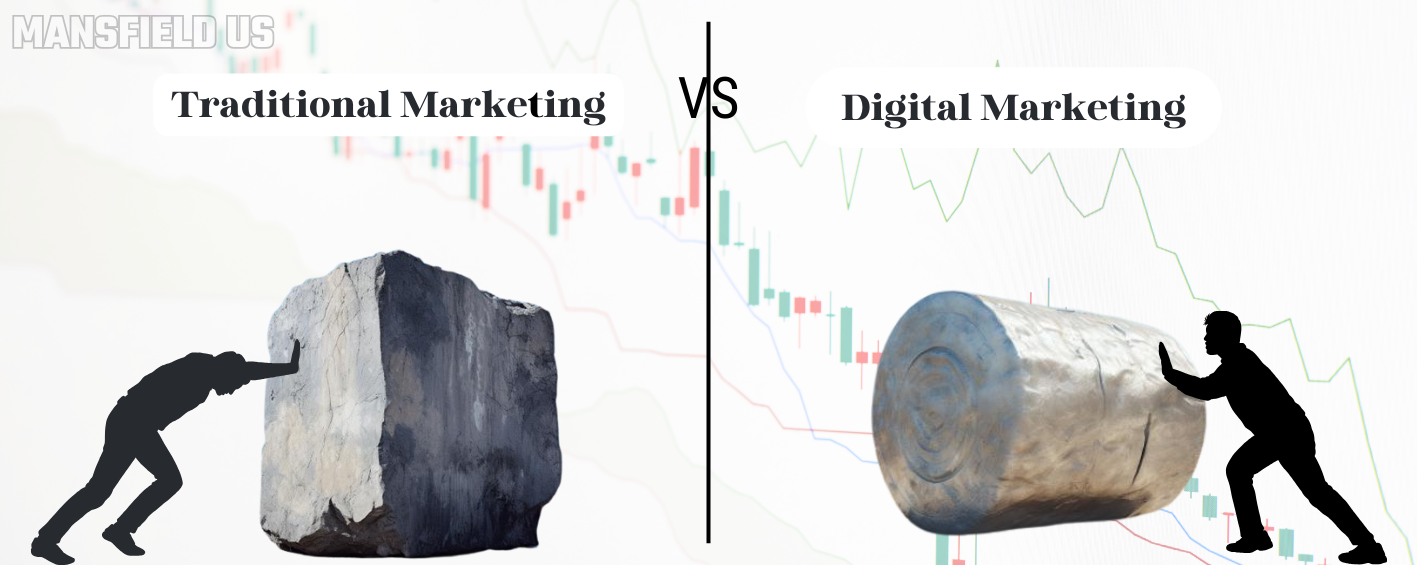Mansfield Marketing Blog & News
Digital Marketing vs Traditional Marketing
Companies are constantly seeking new ways to reach and engage with their target audience. With the rise of social media, online shopping, and other digital platforms, traditional marketing methods may seem outdated or ineffective.
Many businesses continue to rely on more traditional forms of advertising such as newspaper ads, TV commercials, and traditional marketing campaigns.
This begs the question: digital marketing or traditional marketing?
we will delve into the pros and cons of each approach and explore which one might be the better fit for different types of companies.

Understanding the difference between digital marketing
and traditional marketing
As businesses continue to evolve, so do the marketing materials they use to reach their audience. Understanding the difference between online marketing and traditional marketing strategies is increasingly important for achieving success in today's world.
Digital marketing relies on online platforms and technologies to connect with customers, while traditional marketing uses more traditional channels such as print, television and billboards.
Digital ads versus traditional media have many differences, including their level of interactivity, measurability, and targeting capabilities. As a business professional, it's crucial to understand the pros and cons of each channel and determine which one is right for your marketing goals.
The impact of technology on marketing strategies
The emergence of technology has significantly impacted the way businesses approach their marketing strategies. With the rise of digital advertising, companies are faced with the question of whether to stick with traditional methods or shift towards digital marketing.
Digital ads have become increasingly popular due to their ability to reach a wider audience and measure their effectiveness in real-time. However, traditional marketing techniques still hold their ground in certain industries. It is crucial for businesses to weigh their options and determine which approach will work best for them.
The impact of technology on marketing strategies is undeniable and requires constant adaptation to stay ahead of the game.
Cost comparison between digital and traditional marketing methods
As businesses continue to adjust to the constantly evolving world of marketing, one of the biggest considerations they must make is whether to invest in digital or traditional marketing methods.
While traditional marketing such as print ads, brochures, and billboards continue to hold their own in certain markets, digital marketing has taken center stage in recent years with the widespread use of social media, email marketing, and paid advertising.
There are significant differences between the two approaches, particularly when it comes to cost.
Digital marketing, for example, offers more cost-effective ways to reach target audiences on a larger scale, while traditional methods require more financial investment in distribution and production. It's essential for businesses to carefully consider their marketing budget and goals to determine which approach is the right fit for them.

Targeting your audience effectively with digital marketing tactics
Digital marketing offers businesses the means to connect with their target audience. By leveraging digital marketing tactics such as social media, email marketing, and search engine optimization, businesses can target their audience more effectively and generate better results.
It's essential for businesses to understand their audience's preferences, interests, and behaviors to ensure that their digital marketing efforts resonate with them.
The beauty of digital marketing is that it allows businesses to personalize their messaging based on these insights and create a tailored experience for each individual.
By doing so, businesses can build a stronger relationship with their audience, increase engagement, and ultimately drive conversions. In today's fast-paced digital landscape, it's critical that businesses employ effective digital marketing tactics to stay ahead of the competition and reach their target audience effectively.
Measuring success in digital marketing through data analysis
In today's digitally-driven age, success in marketing can be measured using various data analysis tools. The key to measuring the ROI in digital marketing revolves around understanding the various metrics, such as click-through rates, conversion rates, and cost-per-acquisition, that are unique to digital channels.
With the vast amount of data collected by these platforms, digital campaigns can be monitored and optimized in real-time to ensure that your marketing efforts meet your business objectives. Through diligent data analysis, businesses can better understand their customers, streamline their marketing efforts, and ultimately increase their ROI.
Utilizing various channels in digital marketing, such as social media, email, and SEO
In the realm of modern marketing, integrating digital advertising channels has become increasingly crucial for business success. Traditional approaches, such as print ads or billboards, are no longer reliable mainstays in the industry. Instead, focusing on digital avenues has proven to be more effective in reaching target audiences.
Channels such as social media, email marketing, and search engine optimization (SEO) offer unique opportunities to connect with potential customers.
Social media platforms allow for interactive engagement, while email marketing offers personalized content tailored to specific recipients. SEO improves your website's search rankings, generating more visibility and traffic to your site.
By utilizing various digital channels, businesses can maximize their outreach and increase their bottom line.
Attracting Potential Customers Online with Digital Marketing
Making full use of the digital landscape is essential in attracting potential customers. Digital marketing allows businesses to establish a strong online presence, build brand awareness, and attract potential customers.
By utilizing search engine optimization (SEO) tactics, businesses can rank higher on search engine result pages, thereby increasing their visibility to potential customers.
Pay-per-click (PPC) advertising and social media ads on the other hand, helps businesses to drive targeted traffic to their websites, boosting the chances of converting visitors into customers.
Social media marketing, such as Facebook, Instagram, Twitter, and LinkedIn, are also powerful tools in the digital marketing arsenal. They allow businesses to directly interact with their audience, engage them with compelling content, and build lasting relationships. Email marketing, too, remains an effective digital marketing strategy, providing businesses with a direct line of communication to potential customers.

The importance of adapting to changing consumer behavior with digital marketing
Traditional marketing methods are no longer as effective as digital marketing channels. Adapting to the changing consumer behavior with digital marketing is essential for businesses to stay competitive in today's market.
However, it's important to note that digital marketing is not the same as traditional marketing. While both aim to promote a product or service, digital marketing allows for a more personalized approach and better targeting of specific audiences.
Combining traditional and digital marketing for a comprehensive strategy
A comprehensive marketing strategy combines the best of both worlds: traditional and digital. While traditional marketing methods like print advertising and direct mail are still effective, digital marketing has taken over in recent years.
With the rise of social media and online advertising, businesses must adapt to the digital media market to stay relevant.
However, this doesn't mean traditional marketing should be completely abandoned. In fact, it can still be a valuable tool in reaching certain demographics.
Traditional marketing refers to marketing that does not need the internet for advertisement purposes, while digital marketing is any form of marketing that utilizes the internet.
The key is to find the right balance between the two and create a cohesive strategy that leverages the strengths of each. By doing so, businesses can reach a wider audience and achieve their marketing goals.
Making the decision on which form of marketing is
best for your business
There are two primary forms of marketing: traditional and digital.
Traditional marketing encompasses print ads, radio and television commercials, billboards, and direct mail.
Digital marketing includes digital ads, emails, social media, and content marketing. While both methods have pros and cons, digital marketing has become increasingly popular due to its ability to target specific audiences, measure results, and adapt quickly.
This doesn't mean that traditional marketing should be dismissed entirely. Each form has its own strengths and weaknesses, and the choice should ultimately depend on your industry, goals, and marketing campaign.
It's also important to note that digital ads and traditional ads can both be successful, but the message and medium should fit your branding and communication style.
Ultimately, taking the time to weigh your options and strategically plan your marketing efforts can lead to increased brand awareness, customer loyalty, and ultimately, business success.
The ease and efficiency of reaching a wider audience, the cost-effectiveness compared to traditional advertising, and the ability to target specific demographics are just some of the many advantages of digital marketing.
So whether you choose digital or traditional marketing, it's essential to consider your business goals and target audience carefully.
Here at Mansfield Marketing, we understand the importance of utilizing both forms of marketing and offer a professional digital marketing team that offers a variety of services to help your business succeed in today's competitive digital market.
Give us the opportunity to earn your business by contacting us today!











